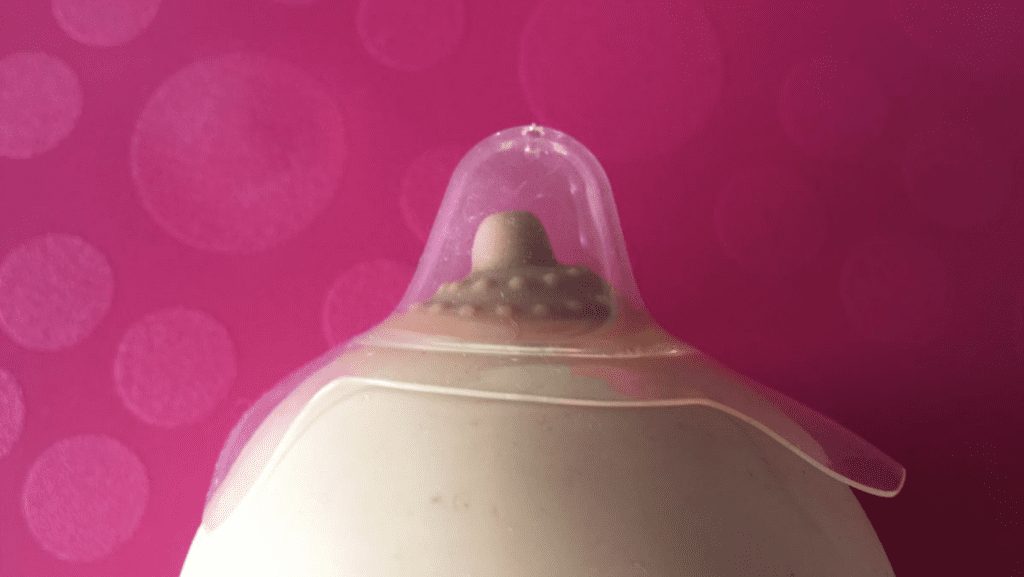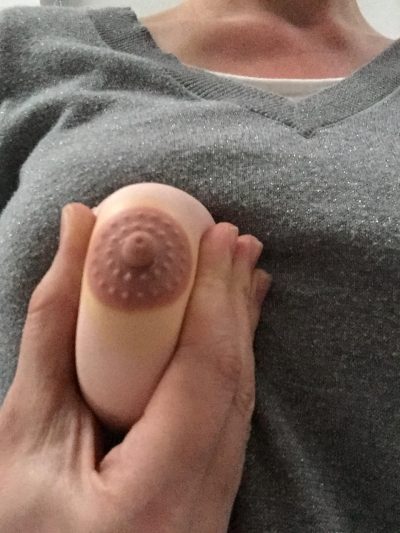
Nipple shields can divide opinion! Whether you want to know if nipple shields might help, or you want to ditch your shields, read on!
I have sore nipples – should I use nipple shields?
This is probably the most common reason women consider using nipple shields. The thought is that if you have nipple trauma, using a nipple shield will protect your nipple from further damage. Unfortunately, that does not always work. To understand why, you need to know where the nipple should be in your baby’s mouth. If your baby is correctly attached to the breast, your nipple will be way back in your baby’s mouth, and he or she won’t damage your nipple.
By definition, if you have sore nipples or nipple damage, your baby doesn’t have enough breast tissue in their mouth. You’ll either need to correctly attach your baby, or work out if there is an anatomical reason why your baby cannot get a big mouthful of breast. Common reasons include being engorged, or restricted tongue movement – sometimes caused by tongue tie, or abnormal suckling.
Alternative strategies to manage nipple damage
If you have nipple pain or trauma, consider the following strategies:
- Improve your baby’s positioning
- Try laid back feeding
- Consider seeking help from an IBCLC lactation consultant
- If your baby has a tongue tie, consider revision of their tie, with ongoing lactation support
- If you have had a difficult, instrumental (ventouse/forceps), long or very short birth, consider having your baby evaluated by a paediatric osteopath
Why the controversy with nipple shields?
You may well have already heard about some theories about why nipple shields can be unhelpful, including:
- Babies can develop a preference for the feel of silicone/latex
- Some people feel that they can reduce milk supply – this is because of the barrier between you and your baby. Through skin to skin contact your body makes prolactin, which is the milk making hormone. The thought is that the reduction in direct skin to skin contact may reduce supply. It is unclear whether and to what extent this is true. What is true is that if the shield is improperly applied, your baby will not be attached deeply, and may not transfer milk effectively. Less milk removed = less milk made.
- If the shield is not on properly, it wont actually prevent pain. You need to make sure that the shield is rolled down over your nipple so that your baby can still get a big mouthful of breast. Otherwise they will still clamp down on the end of your nipple.
Some common scenarios where nipples shields might be useful:
- Breastfeeding a premature baby. Some research shows that preterm babies do not achieve a good enough suction when directly breastfeeding. In some studies, the babies who mothers wore a nipple shield transferred more milk than the babies who directly breastfed. This by NO MEANS is to suggest that they should be dished out to every preterm baby, but certainly if a baby is struggling, then they can make a positive impact.
- Adoptive lactation or re-lactation – often if a baby has already been used to a silicone or latex bottle teat, they may struggle with direct breastfeeding. As an interim measure, to get the baby breastfeeding, nipple shields can be a good tool, sometimes along with a supplemental nursing system, like this one.
- Babies who are refusing the breast. Sometimes, if breastfeeding has got off to a bad start, babies can start to fuss and cry, and bottles become more and more the way the baby is fed. One way to rescue breastfeeding is to use nipple shields. Watch this video to find out more.
- True inverted nipples. I cannot stress enough that nipples do not need to stick out for a baby to effectively breastfeed. However, some babies do seem to struggle when the nipple actually folds further inwards when the baby attaches to the breast. A nipple shield (when all other strategies with a skilled helper have failed) can sometimes turn things around.
- Finally, if you have reached the point where the choice is either; use the shield, or express and bottle feed. I’m quite pragmatic about this. If your only alternative is to use a silicone bottle teat anyway, you might as well cut out the middle man (the pump)!
What sort of nipple shields should I try?
There are many different types of shield, with different materials, shapes and sizes. When choosing one, you need to look for a shield that is the right size for your nipple, and also your baby’s mouth.
My preference is for a shield with a cutaway section on one side. The versions with cutaways on both sides have a harder time staying on. The cutaway types, like this one:

can be useful because they allow your baby to have more breast tissue in their mouth. The instructions usually suggest that you have the cutaway section aligned with your baby’s nose. I recommend the opposite: spin the shield around 180 degrees, so that the cutaway section is aligned with your baby’s lower jaw. The reason for this is that most of the work of feeding is done by the lower jaw. This technique therefore allows for a deeper attachment to the breast.
I do not recommend any particular brand – look at the sizes and pick the one that seems to be a good fit.
How do I put on a nipple shield?
This is the tricky part. Many a mother has lost her temper as her hungry baby flicks off the nipple shield with their flailing hands! I suggest the following:
- Practice using nipple shields at a time when you don’t actually need to feed your baby
- Make sure your breast is not overly full – it’s very hard to apply one if they are engorged. Hand express a little milk first
- Invert the shield and roll it down – watch this video for more help!
I want to stop using nipple shields…
So, if you’ve been using a shield for a time, and want to ditch it, you may find your baby gets a little frustrated. However, there are several different ways to rectify this problem. Try a few of these options and see which ones work:
- First of all, try to start your baby on the shield, and remove it partway through
- Feed your baby when they are very sleepy, to see if they will accept the change
- Try feeding your baby in the bath
- Bounce on a yoga ball whilst feeding, or walking around
- Finally, consider making a ‘nipple sandwich’ to simulate the firmness they experienced with nipples shields –
- like this:

Just be sure to let go of the pressure once your baby is attached, so that you don’t inadvertently block milk ducts!
However your breastfeeding journey pans out, and whether you use nipples shields or not, I wish you well!
Lyndsey Hookway is a paediatric nurse, health visitor, IBCLC, holistic sleep coach, PhD researcher, international speaker and author of 3 books. Lyndsey is also the Co-founder and Clinical Director of the Holistic Sleep Coaching Program, co-founder of the Thought Rebellion, and founder of the Breastfeeding the Brave project. Check Lyndsey’s speaker bio and talk brochure, as well as book her to speak at your event by visiting this page. All Lyndsey’s books, digital guides, courses and webinars can be purchased here, and you can also sign up for her free monthly newsletter here.

Leave A Comment
You must be logged in to post a comment.